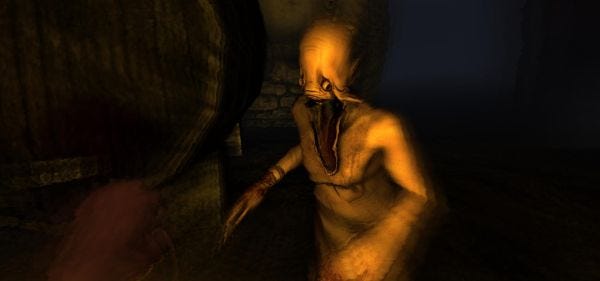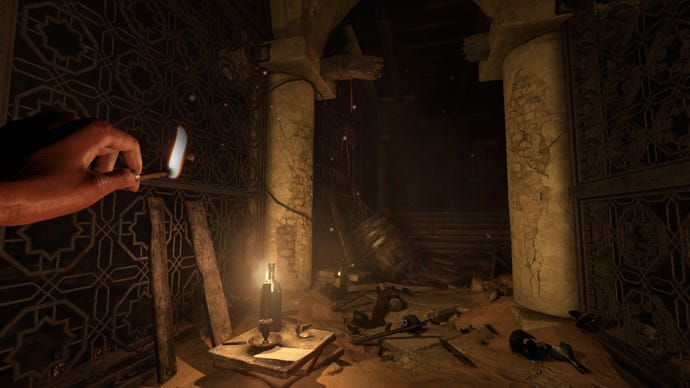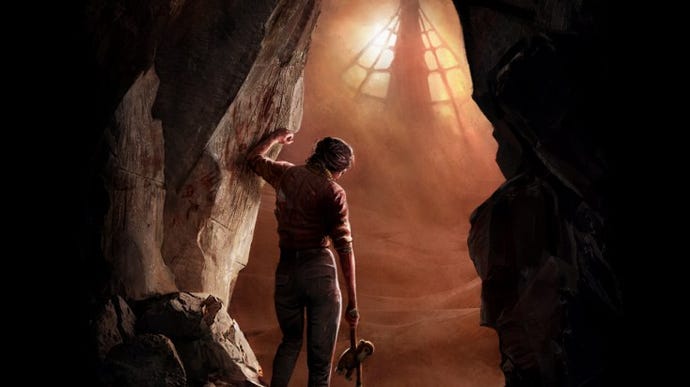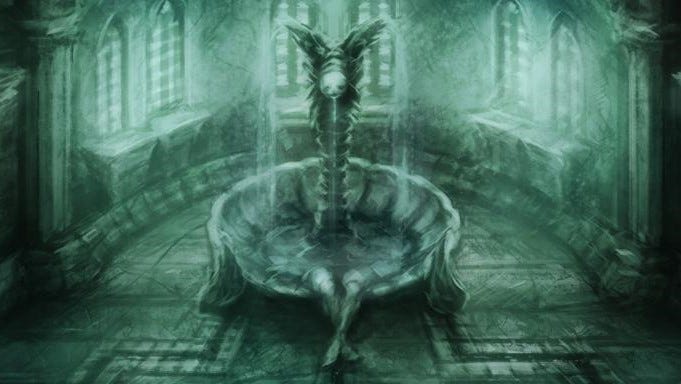Game design as conspiracy theory: what Amnesia learns from Umberto Eco
"One foot in cabala and the other in the laboratory."
The Amnesia games are set decades apart, but they all begin in the same moment, a moment of waking that is also a moment of erasure and disconnection, a rebirth outside the flow of events from which to descend into the machine of history afresh. On 19th August 1839, a young man opens his eyes to find himself in a vast, silent castle in the forests of Prussia. He discovers a letter from his "past self", Daniel, who urges him to murder the castle's secluded owner, a baron named Alexander, and warns that he is being hunted by a monstrous Shadow. 60 years later on New Year's Eve, the celebrated meat factory owner Oswald Mandus starts awake in the opulent stillness of his manor house in London. Hearing the distant voices of his children, he goes to look for them in the "splendid architectures" below.
On 21st July 1916, at the height of World War I, the soldier Henri Clément stumbles from his sickbed in a colossal bunker beneath the Western Front. With nobody about, and no memory of events during his convalescence, he follows a trail of blood through the collapsing tunnels towards the pantry. And on an unknown day in March 1939, the engineering drafter Tasi Trianon wakes in the wreckage of a plane, deep in the Algerian desert, and enters the nearby caves in search of her husband Salim. Four games, four forgotten pasts, four new beginnings, one descent.
Beware: major spoilers for the entire Amnesia series below.
There's no "master plan" for how Amnesia tells its story, as Frictional's co-founder and creative director Thomas Grip tells me. Each game is the work of a different team, with the first sequel, Amnesia: A Machine for Pigs, handled externally by The Chinese Room, and as with game development in general, many of the storytelling choices are born of practical considerations. The Dark Descent is set in the mid-19th century to justify the presence of lightbulbs, for instance, while still ensuring that much of Alexander's castle is lit by flame. But there is a master plan, perhaps, in that there must always be the suspicion of a master plan. To walk the labyrinth of an Amnesia game is to participate in the rediscovery of an ancient conspiracy, forming insidious connections between documented places and events, like the carpets of rot that indicate the Shadow's approach. Alone, lost and helpless, unable to trust your senses and stalked by creatures your character can't bear to look at, you gather a host of letters, diary pages, alchemical scrawls and tales from myth that hint at a greater truth beneath.

Intriguingly, the act of gathering and connecting fragments also seems to describe the writing of Amnesia, a "historical fantasy" that regards history as a fantasy, scraped together and kindled afresh by every generation to light their steps through the present. "The people leading the project have interests, and there are some needs that come from the product itself," Grip says. "And that sort of grows some tentacles that go out to historical events and gather them in. And then those get connected to the entirety of the story."
The games are often presented as Lovecraftian fables - the original Dark Descent game engine is named after the notorious cosmic horror author. But in the tentacular nature of their storytelling, they take as much or more influence from Umberto Eco's novel Foucault's Pendulum - a satirical "secret history" book about three jaded intellectuals, Casubon, Belpo and Diotallevi, who work at a seedy vanity press in 1970s Italy.
Tasked with bodging together an anthology of dubious occult writings, the Garamond Press editors amuse themselves devising a conspiracy about a hidden order of Templar Knights, controlling the world from beneath using "telluric currents". But in the course of assembling this plot, they eventually fall under their own spell, coming to believe that their Plan is real, and that they are being hunted by the Templar cult. Partly, this represents the cumulative, deranging effect of attending far too many syncretic orgies thrown by quacks and cranks; partly, it's a slow distortion born of the uncanny political landscape of their day, in which ideologies multiply and feed on each other during conversations at the bar. But mainly, it is simply that Garamond's editors have a passion for connections and patterns, and far too much raw material at their disposal. They are unable to resist putting the pieces together. And in that regard, they are prototypical Amnesia protagonists.
The eventual spark for the creation of the Plan is, in fact, the act of gathering dropped pages. Later in the book, Belbo knocks over a pile of manuscripts. While gathering them up and trying to remember the correct order, the editors realise that they can fashion their own occult chronology by linking sentences at random with such connective phrases as "this proves that" and "it's obvious that". Much as today's "AI" enthusiasts promote automatic recombination based on datasets as a kind of immaculate conception, Casubon - the book's narrator - proposes using Belpo's computer, nicknamed after the 13th century prophet Abraham Abulafia, both to speed up the process of splicing together texts and to catalyse the results into something magical.
The trio dip into the official record like reckless surgeons, inflaming reports of obscure organisations, joining up people and places and populating spaces of ill-repute. They fill in the gaps around real-life figures, feeding on the strain of mysticism in scientific writing from the Ancient Greeks all the way to quantum physics. Casubon discovers that many canonical authors he had taken for rationalists and scientific positivists also dabbled in the occult. "Men I had studied in school as bearers of mathematical and physical enlightenment now turned up amid the murk of superstition," he observes. "For I discovered that they had worked with one foot in cabala and the other in the laboratory."

Amnesia takes direct inspiration from all this. As Grip summarises, "it's the Foucault Pendulum thing where you find some historical figure, find some historical event, and you're like, 'Shit, no one really knows about this, so let's twist it around and do something with it'." One such historical figure is the 16th century polymath and physician Heinrich Corneilus Agrippa, who lends Foucault's Pendulum an epigraph that could easily grace the loading screen of an Amnesia game: "Ponder the meaning we have dispersed in various places and gathered again."
When Daniel meets Agrippa in The Dark Descent, he has been trapped and mutilated by Alexander, living on forever as a filmy-eyed cadaver with no jaw, who communicates by supernatural means. It's as though he has been literally "twisted" and calcified into lore by the game's storytelling methods - the penalty for being a scholar who kept "one foot in cabala" and so, made himself available to Frictional in their efforts to transform historical record into an occult conspiracy.
Amnesia's protagonists are alike deformed by their roles as the scavengers and reconstructors of each game's events. The series is famous for its sanity systems, which interfere with your ability to see and control your character as they accrue trauma from the sight of horrible entities or places. After reading Foucault's Pendulum, I want to redefine these psychological symptoms not as signs of terror, but as the effects of over-connection. Unchecked conspiratorial thinking causes the thinker to leak at the seams: as Casubon says, "I felt like a walking blender mixing strange concoctions of different liquors." Casubon's sense of reaching critical mass, and his growing inability to distinguish perception from delusion, compares to Daniel's visual impairments and loss of motor control when his sanity is low in The Dark Descent, or Tasi's dissociative breaks in Rebirth.

While Amnesia's monsters are dreadful, the game's sanity effects aren't just a response to them, but to an excess of implication, of knowing so much that the free agency over and above history represented by the player is eroded and finally ejected. As Nietzsche wrote in an "untimely meditation" on the utility of forgetting, the past threatens to become "the gravedigger of the present" if we are too aware of it. To survive each game involves the maintenance of what Nietzsche called a "horizon" of calculated inattentiveness: don't see too much, don't hear too much, avoid grasping the whole too avidly, lest it grasp at you in return.
The critical missing link here is, of course, the past of each protagonist. All have done and witnessed terrible things, to the point that they are helpless to navigate the mire and must delegate responsibility to a less-encumbered "future self" - the player, framed as a byproduct of the amnesia process, who is able to revisit the past from a relatively neutral standpoint and undertake some form of corrective action. Or alternatively, do wicked things in turn. "It's interesting in games where you start out as a blank slate, and you sort of [project] your own identity onto that character to a certain point," Grip notes. "And then, as you learn more and more about them, you're sort of like, yeah, I could have done that."
As a text in itself, Foucault's Pendulum is a conspiratorial structure, madly overwritten and conspicuously pasted-together, a monumental fake. Its prose is a collage of excerpts, e-journal entries and partially deciphered documents, structured according to a cheesy Cabbalistic numbering system, and awash with descriptions of other books on such topics as "hermetic zoology", Atlantis, the pyramids, Celtic stone circles and Rosicrucian rites. Amnesia embraces this profusion of texts in its backstory development, but it also channels a little of the book's cynicism, in that its world-building is rooted in the less romantic consideration that conspiracy theories are economical to produce. One advantage of blending record with invention, after all, is that it's 'world-building for free'. "It's almost a bit of cheap lore, because you can say 'this guy that's mentioned in the history books, he's a magician'," Grip says. "And then all of a sudden you have rich lore, because that person is mentioned by other people in the books, and what did they do?"

The machinations of conspiracy-thinking also have a surprising design benefit in supplying a kind of campaign pacing device. The act of mixing fact with fiction to form a credible conspiracy is mirrored in-game by the alternation of realist locations and fantastical architecture and geography. The Bunker's meticulous recreation of a World War dugout gives way to Roman ruins where splinters of rock float and reverberate. Oswald's meat factory reminds me of the 19th century textile factories of my native Yorkshire, but its production lines feed into steampunk circuitry and the realm of Aztec mythology.
The developers spend a lot of time thinking about how and when to cross that line between period recreation and fable, with Grip conceding that the games are less convincing when they linger too long in the dreamworld. "One moment that I love in particular - I had nothing to do with it, but in A Machine for Pigs, there's a floor that opens up in a church," he says. "And that's a really cool way of doing a historical building that all of a sudden has this dark secret."

At other times, the historical realm in Amnesia persists alongside the nightmare as a kind of taunting exterior, like the woods that surrounds the castle in The Dark Descent. The Prussian forest is a relatively sane, if unforgiving dimension just beyond the navigable plane, glimpsed through scuffed panes as Daniel finds his way to Alexander's lair. "It's very important for us that you can see that there is some normality, and then we can break that feeling later on, by having a falling tree or something," Grip says. "In A Machine for Pigs, you see hints of the big city. And in Rebirth, you can see the desert of Algeria. In some sense, they work as vistas and are not that different from how other games do things. But in another sense, they're a reminder in Amnesia that you have your place in history as it unfolds - that you have this sort of connection."
The positioning of history "outside" the world of the game is most pointed in the latest game, Amnesia: The Bunker, whose real-life frontline periodically splits the air and shakes the roof with artillery reports. I'm not sure how deliberate the effect is, but these detonations form an ironic counterpoint within the game's simulation: they make it harder to track the creature that lives in the walls, both deafening you to signs of imminent attack and jolting you out of the illusion, reminding you that nothing in the Bunker can rival the horrors of the Somme. The historical realm offers no sanctuary here. "There is this pillbox in The Bunker, where you climb up and you can see across the field, and now you're getting a glimpse not into the darkness, but into the history," Grip says. "And then you get shot by a sniper. And that sniper shot was just a cue added by a sound designer and that got turned into an event, if I recall correctly. So it's interesting - again, you can sort of peek through."
The key difference between Amnesia and Foucault's Pendulum, of course, is that while the book's Templar Plan is the result of "[piecing] a lot of surfaces together to create the impression of depth", as Casubon's partner Lia puts it, Amnesia's scattered texts are the pieces of an otherworldy plot. Each game is the act of rediscovering it; there's a sense in which Amnesia is a series of remakes, not sequels.

The secret in question is another dimension, home to a non-human empire of incredible cruelty and industry, hinted at in The Dark Descent, and physically explored by the player in Rebirth. Much like the Amnesia series as a whole, the dark world operates by means of cycles of forgetting. It captures other lifeforms and brutalises them to convert their pain and fear into a form of energy, "vitae", administering potions to wipe the memories of victims and stop them becoming desensitised to their suffering. By the time you step between dimensions in Rebirth, the empire has undergone a catastrophe resulting from an abortive act of sabotage, and the only real survivor is the Empress herself, kept alive forever by the screaming vitae factories surrounding her tower, which are tended by the revenants of her magicians. The dark world has become time-locked under a sickly white sun, continually deleting the pasts of its many prisoners to extend the reign of its ruler. The existence of this imperial purgatory - positioned at the far end of each Amnesia story, with your character's own self-erasure at the other - threatens to obliterate the sequential history you reconstruct in each game. It collapses everything into a single rite of repeated, futile remembering.
There's no hideous alternate reality to unearth in Foucault's Pendulum, but Eco also plays with the paralysis and disintegration of linear history by a conspiracy that overwrites the concept of time, reducing everything to an indefinite endgame. The more elaborate and compelling the Plan grows, the more it renders past and future events interchangeable, transmuting them into symbols and surmises that link up and multiply in defiance of causation. As the avuncular occultist Agliè tells Casubon, "nothing moves, and there is only one point, the one from which all the others are generated at the same instant". To make headway in such an unhistorical world, Agliè argues, it isn't enough to think in terms of befores and afters: "you must reason not according to the logic of time but according to Tradition."
Among the traditions Amnesia draws upon is the cult of Mithras, a Roman god inherited from Zoroastrianism, whose underground temples or "mithraea" are found throughout the former territories of the Roman empire. The mithraea lend themselves nicely to weavers of occult tales in being at once widespread and in many cases, visitable, yet only partly understood and open to interpretation. They occupy a flexible hinterland between empirical reality and make-believe.
To enter a mithraeum, you must descend. Each is either built within, or designed to resemble a cave. By contrast, the temples of many other Roman gods are open to the air, the better to attract potential converts. At the centre of the structure, you'll find a mural depicting Mithras himself slaying a bull, the symbolism of which is much-debated, but which strikes me as a generative spilling of life energies, the necessary mutilation before the feast. Every Amnesia game is a sort of an exercise in entering the mithraeum called "history" with hands scrubbed suspiciously clean, and finding at the bottom an endless act of torture.










